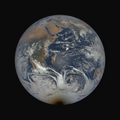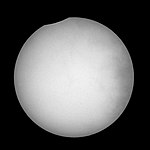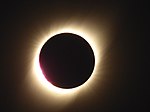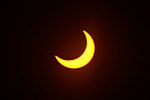
A total solar eclipse took place on November 23, 2003, with a magnitude of 1.0379. A solar eclipse occurs when the Moon passes between Earth and the Sun, thereby totally or partly obscuring the image of the Sun for a viewer on Earth. A total solar eclipse occurs when the Moon's apparent diameter is larger than the Sun's, blocking all direct sunlight, turning day into darkness. Totality occurs in a narrow path across Earth's surface, with the partial solar eclipse visible over a surrounding region thousands of kilometres wide. It was visible from a corridor in the Antarctic region. A partial eclipse was seen from the much broader path of the Moon's penumbra, including the southern tip of South America and most of Australia.

An annular solar eclipse occurred at the Moon's descending node of the orbit on October 3, 2005, with a magnitude of 0.958. A solar eclipse occurs when the Moon passes between Earth and the Sun, thereby totally or partly obscuring the image of the Sun for a viewer on Earth. An annular solar eclipse occurs when the Moon's apparent diameter is smaller than the Sun's, blocking most of the Sun's light and causing the Sun to look like an annulus (ring). An annular eclipse appears as a partial eclipse over a region of the Earth thousands of kilometres wide. Occurring only 4.8 days after apogee, the Moon's apparent diameter was smaller. It was visible from a narrow corridor through the Iberian peninsula and Africa and Brazil. A partial eclipse was seen from the much broader path of the Moon's penumbra, including all of Europe, Africa and southwestern Asia. The Sun was 96% covered in a moderate annular eclipse, lasting 4 minutes and 32 seconds and covering a broad path up to 162 km wide. The next solar eclipse in Africa occurred just 6 months later.

An annular solar eclipse occurred at the Moon's ascending node of the orbit on Monday, January 26, 2009. A solar eclipse occurs when the Moon passes between Earth and the Sun, thereby totally or partly obscuring the image of the Sun for a viewer on Earth. An annular solar eclipse occurs when the Moon's apparent diameter is smaller than the Sun's, blocking most of the Sun's light and causing the Sun to look like an annulus (ring). An annular eclipse appears as a partial eclipse over a region of the Earth thousands of kilometres wide. It had a magnitude of 0.9282 and was visible from a narrow corridor beginning in the south Atlantic Ocean and sweeping eastward 900 km south of Africa, slowly curving northeast through the Indian Ocean. Its first landfall was in the Cocos Islands followed by southern Sumatra and western Java. It continued somewhat more easterly across central Borneo, across the northwestern edge of Celebes, then ending just before Mindanao, Philippines. The duration of annularity at greatest eclipse lasted 7 minutes, 53.58 seconds, but at greatest duration lasted 7 minutes, 56.05 seconds.
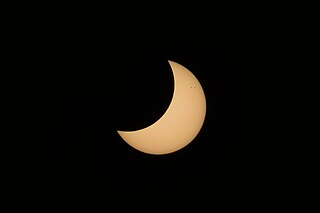
An annular solar eclipse occurred on Tuesday, April 29, 2014. A solar eclipse occurs when the Moon passes between Earth and the Sun, thereby totally or partly obscuring the image of the Sun for a viewer on Earth. An annular solar eclipse occurs when the Moon's apparent diameter is smaller than the Sun's, blocking most of the Sun's light and causing the Sun to look like an annulus (ring). An annular eclipse appears as a partial eclipse over a region of the Earth thousands of kilometres wide. The center of the Moon's shadow missed the Earth's South Pole, but the partial eclipse was visible from parts of Antarctica and Australia, and an annular eclipse was visible from a small part of Antarctica.

A total solar eclipse occurred at the ascending node of the Moon's orbit on Tuesday, July 2, 2019, with an eclipse magnitude of 1.0459. Totality was visible from the southern Pacific Ocean east of New Zealand to the Coquimbo Region in Chile and Central Argentina at sunset, with the maximum of 4 minutes 33 seconds visible from the Pacific Ocean. The Moon was only 2.4 days before perigee, making it fairly large.
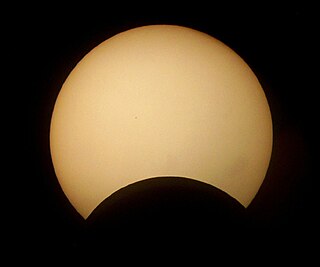
An annular solar eclipse occurred at the Moon's descending node of the orbit on September 22, 2006. A solar eclipse occurs when the Moon passes between Earth and the Sun, thereby totally or partly obscuring the image of the Sun for a viewer on Earth. An annular solar eclipse occurs when the Moon's apparent diameter is smaller than the Sun's, blocking most of the Sun's light and causing the Sun to look like an annulus (ring). An annular eclipse appears as a partial eclipse over a region of the Earth thousands of kilometres wide. The path of annularity of this eclipse passed through Guyana, Suriname, French Guiana, the northern tip of Roraima and Amapá of Brazil, and the southern Atlantic.

An annular solar eclipse occurred at the Moon's ascending node of the orbit on February 7, 2008. A solar eclipse occurs when the Moon passes between Earth and the Sun, thereby totally or partly obscuring the image of the Sun for a viewer on Earth. An annular solar eclipse occurs when the Moon's apparent diameter is smaller than the Sun's, blocking most of the Sun's light and causing the Sun to look like an annulus (ring). An annular eclipse appears as a partial eclipse over a region of the Earth thousands of kilometres wide. Occurring 7 days after apogee and 6.9 days before perigee, the Moon's apparent diameter was near the average diameter.

An annular solar eclipse occurred on Thursday, June 10, 2021, when the Moon passed between Earth and the Sun, thereby partly obscuring the image of the Sun for a viewer on Earth. During the eclipse, the Moon's apparent diameter was smaller than the Sun's, so it caused the Sun to look like an annulus. The annular eclipse was visible from parts of northeastern Canada, Greenland, the Arctic Ocean, and the Russian Far East, whilst the eclipse appeared partial from a region thousands of kilometres wide, which included northeastern North America, most of Europe, and northern Asia.
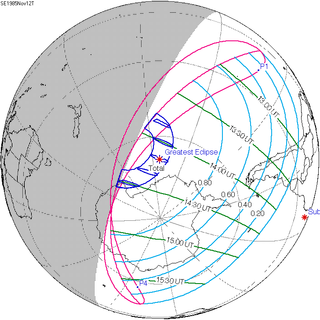
A total solar eclipse occurred on November 12, 1985. A solar eclipse occurs when the Moon passes between Earth and the Sun, thereby totally or partly obscuring the image of the Sun for a viewer on Earth. A total solar eclipse occurs when the Moon's apparent diameter is larger than the Sun's, blocking all direct sunlight, turning day into darkness. Totality occurs in a narrow path across Earth's surface, with the partial solar eclipse visible over a surrounding region thousands of kilometres wide. It was visible only near Antarctica.

A total solar eclipse will occur on December 5, 2048. A solar eclipse occurs when the Moon passes between Earth and the Sun, thereby totally or partly obscuring the image of the Sun for a viewer on Earth. A total solar eclipse occurs when the Moon's apparent diameter is larger than the Sun's, blocking all direct sunlight, turning day into darkness. Totality occurs in a narrow path across Earth's surface, with the partial solar eclipse visible over a surrounding region thousands of kilometres wide.
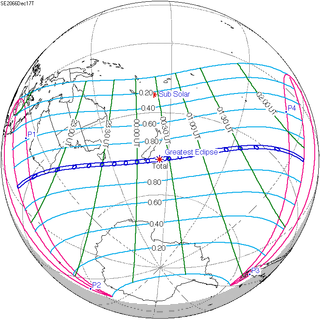
A total solar eclipse will occur on December 17, 2066. A solar eclipse occurs when the Moon passes between Earth and the Sun, thereby totally or partly obscuring the image of the Sun for a viewer on Earth. A total solar eclipse occurs when the Moon's apparent diameter is larger than the Sun's, blocking all direct sunlight, turning day into darkness. Totality occurs in a narrow path across Earth's surface, with the partial solar eclipse visible over a surrounding region thousands of kilometres wide.
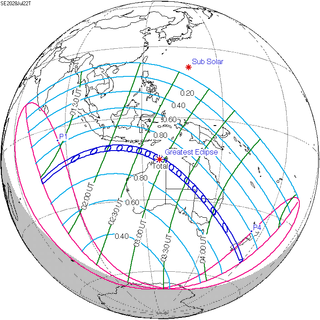
A total solar eclipse will occur on Saturday, July 22, 2028. The central line of the path of the eclipse will cross the Australian continent from the Kimberley region in the north west and continue in a south-easterly direction through Western Australia, the Northern Territory, south-west Queensland and New South Wales, close to the towns of Wyndham, Kununurra, Tennant Creek, Birdsville, Bourke and Dubbo, and continuing on through the centre of Sydney, where the eclipse will have a duration of over three minutes. It will also cross Queenstown and Dunedin, New Zealand. Totality will also be viewable from two of Australia's external territories: Christmas Island and Cocos (Keeling) Island.

An annular solar eclipse occurred on October 14, 2023. A solar eclipse occurs when the Moon passes between Earth and the Sun, thereby totally or partly obscuring the image of the Sun for a viewer on Earth. An annular solar eclipse occurs when the Moon's apparent diameter is smaller than the Sun's, blocking most of the Sun's light and causing the Sun to look like an annulus (ring). An annular eclipse appears as a partial eclipse over a region of the Earth thousands of kilometres or miles wide. Occurring only 4.6 days after apogee, the Moon's apparent diameter was small.
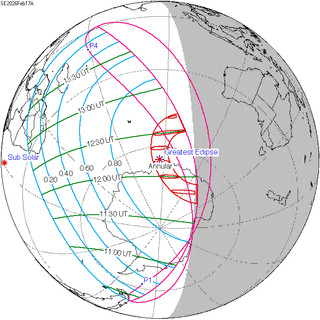
An annular solar eclipse will occur on Tuesday, February 17, 2026. A solar eclipse occurs when the Moon passes between Earth and the Sun, thereby totally or partly obscuring the image of the Sun for a viewer on Earth. An annular solar eclipse occurs when the Moon's apparent diameter is smaller than the Sun's, blocking most of the Sun's light and causing the Sun to look like an annulus (ring). An annular eclipse appears as a partial eclipse over a region of the Earth thousands of kilometres wide.

An annular solar eclipse occurred on January 16, 1972. A solar eclipse occurs when the Moon passes between Earth and the Sun, thereby totally or partly obscuring the image of the Sun for a viewer on Earth. An annular solar eclipse occurs when the Moon's apparent diameter is smaller than the Sun's, blocking most of the Sun's light and causing the Sun to look like an annulus (ring). An annular eclipse appears as a partial eclipse over a region of the Earth thousands of kilometres wide.

An annular solar eclipse will occur on Friday, October 25, 2041. A solar eclipse occurs when the Moon passes between Earth and the Sun, thereby totally or partly obscuring the image of the Sun for a viewer on Earth. An annular solar eclipse occurs when the Moon's apparent diameter is smaller than the Sun's, blocking most of the Sun's light and causing the Sun to look like an annulus (ring). An annular eclipse appears as a partial eclipse over a region of the Earth thousands of kilometres wide.
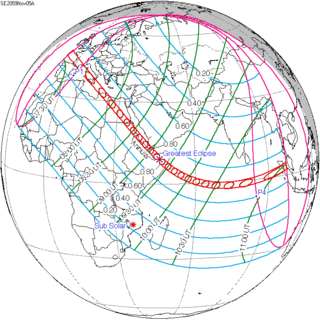
An annular solar eclipse will occur on November 5, 2059. A solar eclipse occurs when the Moon passes between Earth and the Sun, thereby totally or partly obscuring the image of the Sun for a viewer on Earth. An annular solar eclipse occurs when the Moon's apparent diameter is smaller than the Sun's, blocking most of the Sun's light and causing the Sun to look like an annulus (ring). An annular eclipse appears as a partial eclipse over a region of the Earth thousands of kilometres wide. The Sun will be 94% covered in a moderate annular eclipse, lasting 7 minutes exactly and covering a broad path up to 238 km wide.
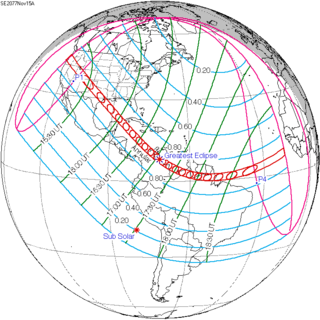
An annular solar eclipse will occur on Monday, November 15, 2077, with a magnitude of 0.9371. A solar eclipse occurs when the Moon passes between Earth and the Sun, thereby totally or partially obscuring the image of the Sun for a viewer on Earth. An annular solar eclipse occurs when the Moon's apparent diameter is smaller than the Sun's, blocking most of the Sun's light and causing the Sun to look like an annulus (ring). An annular eclipse appears as a partial eclipse over a region of the Earth thousands of kilometres wide. The path of annularity will cross North America and South America. This will be the 47th solar eclipse of Saros cycle 134. A small annular eclipse will cover only 93.71% of the Sun in a very broad path, 262 km wide at maximum, and will last 7 minutes and 54 seconds. Occurring only 4 days after apogee, the Moon's apparent diameter is smaller.

A total solar eclipse will occur on April 11, 2070. A solar eclipse occurs when the Moon passes between Earth and the Sun, thereby totally or partly obscuring the image of the Sun for a viewer on Earth. A total solar eclipse occurs when the Moon's apparent diameter is larger than the Sun's, blocking all direct sunlight, turning day into darkness. Totality occurs in a narrow path across Earth's surface, with the partial solar eclipse visible over a surrounding region thousands of kilometres wide.
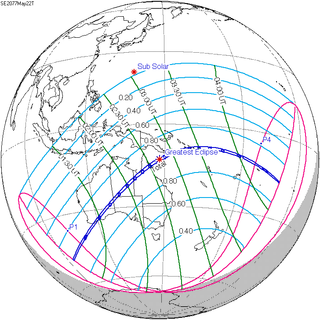
A total solar eclipse will occur on Saturday, May 22, 2077. A solar eclipse occurs when the Moon passes between Earth and the Sun, thereby totally or partly obscuring the image of the Sun for a viewer on Earth. A total solar eclipse occurs when the Moon's apparent diameter is larger than the Sun's, blocking all direct sunlight, turning day into darkness. Totality occurs in a narrow path across Earth's surface, with the partial solar eclipse visible over a surrounding region thousands of kilometres wide.


